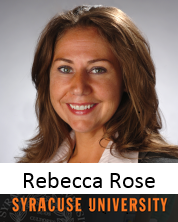I have never heard “that is a crazy idea!” when I tell people what I do. On the contrary I’m often met with, “I wish someone would have taught me how to manage my money when I was in college.” As an assistant director of financial literacy and education programs at Syracuse University, I have seen student class after student class arrive on campus with little to no basic financial management knowledge.
As much as we want to believe students are receiving money management knowledge at home or in high school, they are not. In fact, a recent National Foundation for Credit Counseling Financial Literacy Survey confirms 60% of adults do not have a budget and 40% give their knowledge of personal finance a grade of “C” or worse.
Knowing that adults are rating themselves low on the financial literacy scale solidifies our students are arriving on our campus “green” when it comes to having a money management skill set.
For more information about where students rank in financial literacy, read Where Does the U.S. Rank in the PISA Global Financial Literacy Report?
The question then becomes “Whose responsibility is it to teach financial literacy?” Over the years this discussion has been up for debate.
Some think it is a secondary education responsibility. Secondary education may believe it is primary education’s responsibility. Primary education could believe it is the parent’s responsibility.
The parents perhaps believe it is higher education’s responsibility. Higher education could consider it to be secondary educations responsibility.
The cycle continues on and on and eventually, with the passing of the “buck”, our new college graduates are no further along with financial knowledge then their parents before them.
It is time to halt the “who should be doing what” when it comes to financial education and continue the financial literacy movement right here, right now on our college campuses.
We invite our students in to our academic environment to educate, train and provide skills to help them be successful in their careers.
Financial education needs to be a parallel education to the already great academic education our students receive, it needs to be the norm and each college administrator should have the confidence that their future alumni with leave their institution with the not only a professional skill set but also exiting our institutions with reasonable debt and the knowledge to manage their finances as they begin their careers.
To see examples of forward thinking schools that have implemented financial literacy courses, read Law Schools at Yale and Fordham put Financial Literacy on the Docket
“How do you start?” “When can you start?” “How do we know we are providing the right material for our students?” Our offices are faced with reduced budgets, limited resources and perhaps staff with little or no formal financial literacy training themselves.
Starting a new program and perhaps introducing new ideologies can be like a Six Flags roller coaster, many ups, many downs, one pass you may feel sick and the other you may question why you even got on the ride in the first place.
To overcome the obstacles set before us when developing and maintaining a financial literacy program I’ve found it beneficial to create and follow a model. The model I continue to use to drive our financial literacy program to a straight track of success is:
F.O.C.U.S. Model
F. Foundation
- Does your program match the college/university values?
- Who is your program for?
- What is the message you want your participants to receive?
- What do you want your participants to learn?
Re-visit the mission statement of your university or education system. If your university is a faith-based culture or the college serves primarily nontraditional students, the platform of your program should match the core of your institutions values and the student it serves.
O. Order
- What comes first, second, third, etc. in program implementation?
Examples:
- Website
- In-Person presentations
- Online Activities
- Peer Mentoring
- Events
Depending on your institution, how you deliver your financial literacy program could be a huge success or a disastrous flop depending on how you introduce the program.
If your college is primarily on line learners there would be little benefit to introduce in person presentation as the lead marketing of your program. Rather, you would want to provide and market online tutorials, lessons and/or learning modules to your students.
C. Cultivate
- Who will deliver the program?
- Staff or new hire?
- What education is needed?
- How will you educate yourself to educate the participants?
Staff? Students? Who is going to deliver the program and what type of training is a necessary is part of Cultivation.
You may need to formally train the staff through financial education classes on your campus or certification programs through a third party.
You may consider hiring a director who is already a certified financial manager or you might train staff via a training manual developed in house.
Whichever direction you go, it is crucial the staff responsible for the delivery of your literacy program is knowledgeable in financial matters as it will gain the trust of your students and promotes confidence in your staff.
U. Utilize your resources
- What resources are available to you on your campus?
- Do you have a budget?
- What is the budget?
- How can training and development be utilized?
This stage is mostly all about networking and protecting your budget if you have one.
Does your career services provide training or outreach you can piggy back on? Would your School of Education share the cost of a Graduate Assistant to work with in your office and assist in financial education? How many events are held on campus that you can join to promote your program?
These are some questions to consider when searching for resources on your campus.
S. Start
- Begin your program.
- Commit to the program.
- Always keep the FOCUS in mind.
Begin! Stop talking about it, put down the article on how to do it and begin! Be confident in all the planning, research and design you have done will provide your students with a great financial literacy program.
Most importantly, roll out your program to include two to three year plan so your students have your commitment that you are available to provide financial literacy to them throughout their college career.
You will stumble, learn from and adjust to what works and what doesn’t but as long as you continue to circle back and remind yourself of a simple model like F.O.C.U.S., you should have many, many successful years with your financial literacy program.
Accepting the great challenge of providing a financial literacy program on your campus sets a path of financial greatness for our students. We can feel confident and assured the lessons taught will be utilized while the students are with us and long after they graduate. You might even hear “Thank you for teaching me how to manage my money while I’m in college.”
For more information about how exposing students to financial literacy curriculum promotes responsible student loan borrowing, read iGrad Survey Shows Financial Literacy Leads to Smarter Student Loan Borrowing
 Rebecca Rose is the Assistant Director of Financial Literacy and Education Programs at Syracuse University. In her 19 year career in financial aid she has held positions such as financial aid counselor, loan education specialist and Assistant Director. Her current primary responsibilities are to oversee the development, implementation and continued success of the award winning "I Otto Know This!" financial literacy program at Syracuse University.
Rebecca Rose is the Assistant Director of Financial Literacy and Education Programs at Syracuse University. In her 19 year career in financial aid she has held positions such as financial aid counselor, loan education specialist and Assistant Director. Her current primary responsibilities are to oversee the development, implementation and continued success of the award winning "I Otto Know This!" financial literacy program at Syracuse University.
She holds a Master's Degree in Education from Elmira College with advanced certificates in Training of Trainers, Human Resources Development and is a certified Personal Financial Manager.









